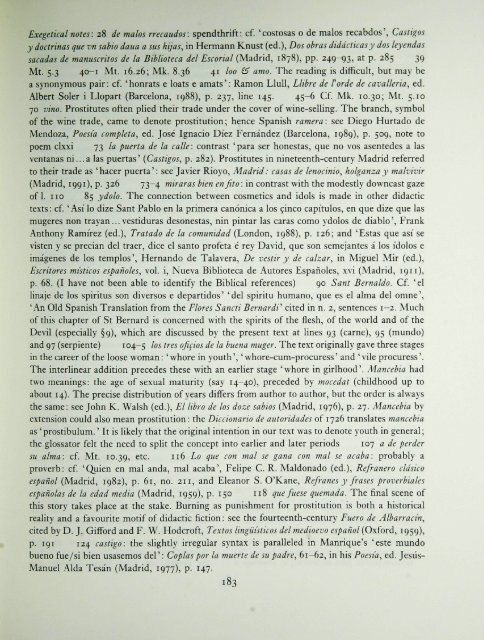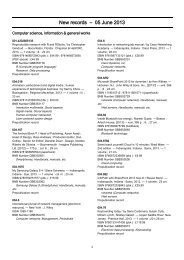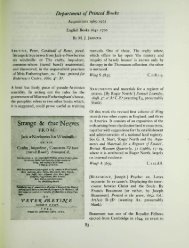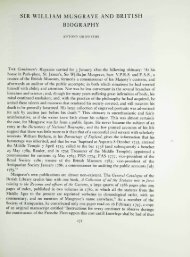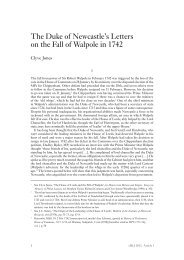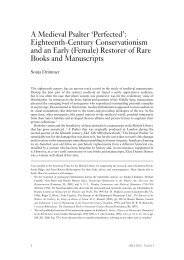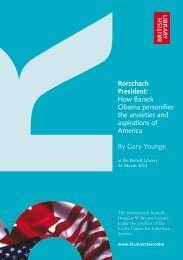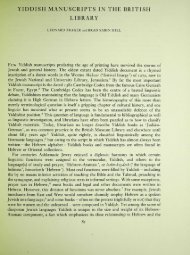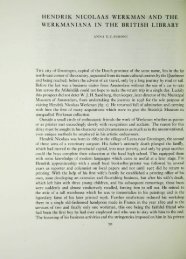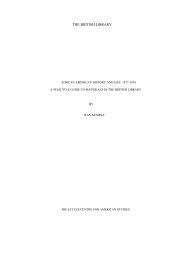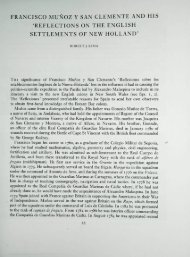AN OLD SPANISH TALE FROM ADD. MS. 14040, flf ... - British Library
AN OLD SPANISH TALE FROM ADD. MS. 14040, flf ... - British Library
AN OLD SPANISH TALE FROM ADD. MS. 14040, flf ... - British Library
Create successful ePaper yourself
Turn your PDF publications into a flip-book with our unique Google optimized e-Paper software.
Exegetical notes: 28 de malos rrecaudos: spendthrift: cf. 'costosas o de malos recabdos', Castigos<br />
y doctrinas que vn sabio daiia a sus hijas, in Hermann Knust (ed.), Dos obras diddcticasy dos leyendas<br />
sacadas de manuscritos de la Biblioteca del Escorial (Madrid, 1878), pp. 249-93, at p. 285 39<br />
Mt. 5.3 40-1 Mt. 16.26; Mk. 8.36 41 loo £5* amo. The reading is difficult, but may be<br />
a synonymous pair: cf. 'honrats e loats e amats': Ramon Llull, Llibre de Porde de cavalleria, ed.<br />
Albert Soler i Llopart (Barcelona, 1988), p. 237, line 145. 45-6 Cf. Mk. 10.30; Mt. 5.10<br />
70 vino. Prostitutes often plied their trade under the cover of wine-selling. The branch, symbol<br />
ofthe wine trade, came to denote prostitution; hence Spanish ramera: see Diego Hurtado de<br />
Mendoza, Poesi'a completa^ ed. Jose Ignacio Di'ez Fernandez (Barcelona, 1989), p. 509, note to<br />
poem clxxi 73 la puerta de la calle: contrast ' para ser honestas, que no vos asentedes a las<br />
ventanas ni...a las puertas' {Castigos, p. 282). Prostitutes in nineteenth-century Madrid referred<br />
to their trade as 'hacer puerta': see Javier Rioyo, Madrid: casas de lenocinio, holganzay malvivir<br />
(Madrid, 1991), p. 326 73-4 fniraras bien en fito: in contrast with the modestly downcast gaze<br />
of 1. no 85 ydolo. The connection between cosmetics and idols is made in other didactic<br />
texts: cf. ' Asi lo dize Sant Pablo en la primera canonica a los 9inco capitulos, en que dize que las<br />
mugeres non trayan... vestiduras desonestas, nin pintar las caras como ydolos de diablo', Frank<br />
Anthony Ramirez (ed.), Tratado de la comunidad (London, 1988), p. 126; and * Estas que asi se<br />
visten y se precian del traer, dice el santo profeta e rey David, que son semejantes a los ldolos e<br />
imagenes de los templos', Hernando de Talavera, De vestir y de calzar, in Miguel Mir (ed.),<br />
Escritores mi'sticos espafioles, vol. i, Nueva Biblioteca de Autores Espaiioles, xvi (Madrid, 1911),<br />
p. 68. (I have not been able to identify the Biblical references) 90 Sant Bernaldo. Cf. 'el<br />
linaje de los spiritus son diversos e departidos' 'del spiritu humano, que es el alma del omne',<br />
'An Old Spanish Translation from the Flores Sancti Bernard^ cited in n. 2, sentences 1-2. Much<br />
of this chapter of St Bernard is concerned with the spirits of the flesh, of the world and of the<br />
Devil (especially §9), which are discussed by the present text at lines 93 (carne), 95 (mundo)<br />
and 97 (serpiente) 104-5 ^os tres offios de la buena muger. The text originally gave three stages<br />
in the career ofthe loose woman: 'whore in youth', ' whore-cum-procuress' and 'vile procuress'.<br />
The interlinear addition precedes these with an earlier stage 'whore in girlhood'. Mancebia had<br />
two meanings: the age of sexual maturity (say 14-40), preceded by mocedat (childhood up to<br />
about 14). The precise distribution of years differs from author to author, but the order is always<br />
the same: see John K. Walsh (ed.). El libro de los doze sabios (Madrid, 1976), p. 27. Mancebia by<br />
extension could also mean prostitution: the Diccionario de autoridades of 1726 translates mancebia<br />
as 'prostibulum.' It is likely that the original intention in our text was to denote youth in general;<br />
the glossator felt the need to split the concept into earlier and later periods 107 a de perder<br />
su alma: cf. Mt. 10.39, ^*^^- ^^^ -^^ ?"^ "^^^ "^^^ ^^ gana con mal se acaba: probably a<br />
proverb: cf. 'Quien en mal anda, mal acaba', Felipe C. R. Maldonado (ed.), Refranero cldsico<br />
espanol (Madrid, 1982), p. 61, no. 211, and Eleanor S. O'Kane, Refranes y frases proverbiales<br />
espanolas de la edad media (Madrid, 1959), p. 150 118 que fuese quemada. The final scene of<br />
this story takes place at the stake. Burning as punishment for prostitution is both a historical<br />
reality and a favourite motif of didactic fiction: see the fourteenth-century Fuero de Albarracin,<br />
cited by D. J. Gifford and F. W. Hodcroft, Textos lingtitsticos del medioevo espafiol (Oxford, 1959),<br />
p. 191 124 castigo: the slightly irregular syntax is paralleled in Manrique's 'este mundo<br />
bueno fue/si bien usasemos del': Coplaspor la muerte de su padre, 61-62, in his Poesi'a, ed. Jesiis-<br />
Manuel Alda Tesan (Madrid, 1977), p. 147.<br />
183


